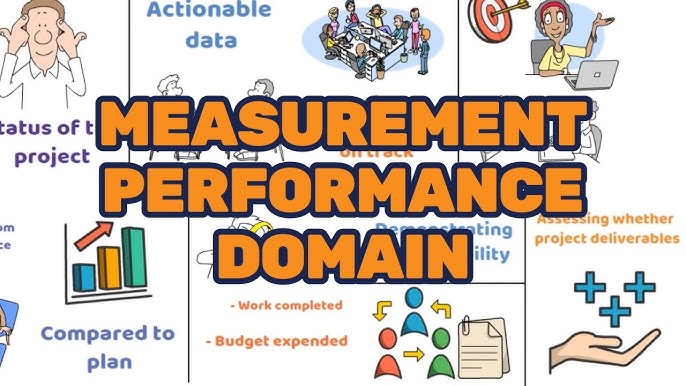PMBOK – Measurement Performance Domain: Tracking What Truly Matters in Project Success
In a world where project success is increasingly defined by value delivery and stakeholder satisfaction rather than simply meeting scope, schedule, and cost baselines, the Measurement Performance Domain outlined in the PMBOK® Guide – Seventh Edition offers a modern, insightful approach to project performance tracking. This domain is critical for monitoring progress, validating assumptions, evaluating performance, and ultimately ensuring that the project delivers the expected outcomes and benefits.
In this blog post, we’ll explore the Measurement Performance Domain in depth—examining its purpose, core components, benefits, and best practices. Whether you are a seasoned project manager or a newcomer to modern project management principles, understanding this domain will sharpen your ability to track what truly matters.
What Is the Measurement Performance Domain?
The Measurement Performance Domain is one of eight performance domains introduced in the PMBOK® Guide – Seventh Edition. It focuses on the methods, metrics, tools, and processes used to assess project performance and progress toward outcomes and value realization.
PMI Definition:
“The Measurement Performance Domain addresses the assessment and monitoring of project performance and the taking of appropriate actions to maintain acceptable performance.”
Unlike traditional metrics focused heavily on scope, schedule, and cost, this domain expands the lens to include value, stakeholder satisfaction, team health, and benefits realization. It supports the principle that measurement should guide decision-making and improvement—not just reporting.
Purpose of the Measurement Performance Domain
The primary purpose of the Measurement Performance Domain is to ensure that:
- The project stays aligned with business objectives.
- Project performance is continuously assessed using relevant metrics.
- Issues are detected early and corrective actions are taken.
- Data supports proactive and informed decision-making.
- Value delivery and outcome achievement are visible and traceable.
In essence, measurement is not about paperwork or metrics for metrics’ sake. It’s about using data to drive meaningful action and ensure continuous alignment with project goals.
Key Components of the Measurement Performance Domain
To measure project performance effectively, this domain incorporates several interconnected elements:
1. Measurement Objectives
The first step is defining what you want to measure and why. Objectives should align with organizational goals and stakeholder expectations.
Examples of objectives:
- Track progress against milestones.
- Monitor cost efficiency.
- Evaluate team engagement or satisfaction.
- Measure delivered value versus expected value.
2. Key Performance Indicators (KPIs)
KPIs are quantifiable metrics that indicate whether a project is on track.
Common project KPIs include:
- Schedule variance (SV)
- Cost performance index (CPI)
- Net promoter score (NPS)
- Team velocity (in Agile projects)
- Value delivered vs. planned value
Effective KPIs are:
- Specific
- Measurable
- Aligned with goals
- Actionable
3. Baseline Comparisons
Baselines provide reference points against which performance is measured. These typically include:
- Scope baseline
- Schedule baseline
- Cost baseline
Measuring deviations from these baselines helps identify risks, issues, and the need for corrective actions.
4. Feedback Mechanisms
Performance measurement isn’t complete without feedback loops. This includes:
- Retrospectives and reviews
- Customer and stakeholder feedback
- Lessons learned sessions
- Team pulse checks
Feedback supports course correction and continuous improvement.
5. Information Radiators
Visual tools that show real-time performance data to stakeholders and teams. Examples include:
- Burn-down and burn-up charts
- Dashboards
- Cumulative flow diagrams
- Kanban boards
They provide transparency and improve collaboration.
Measurement Across Project Lifecycle Phases
Measurement evolves throughout the project lifecycle. Here’s how:
Initiation Phase:
- Define success criteria
- Establish measurement objectives
- Set initial baselines
Planning Phase:
- Choose KPIs and metrics
- Develop reporting mechanisms
- Align metrics with stakeholder needs
Execution Phase:
- Monitor performance in real-time
- Compare actual vs. planned results
- Use dashboards, stand-ups, and status meetings
Monitoring and Controlling Phase:
- Track variances and trends
- Perform root cause analysis
- Take corrective or preventive actions
Closing Phase:
- Assess project outcomes vs. planned value
- Capture lessons learned
- Evaluate stakeholder satisfaction
Types of Metrics in Project Measurement
Metrics fall into several categories. Effective performance measurement involves a combination of these:
1. Leading Indicators
- Predict future performance
- Help in proactive decision-making
- Example: Team velocity predicts sprint completion rates
2. Lagging Indicators
- Show past performance
- Used for analysis and learning
- Example: Budget variance after project completion
3. Quantitative Metrics
- Based on numerical data
- Example: % completion of tasks, actual cost, hours worked
4. Qualitative Metrics
- Based on observations, feedback, or ratings
- Example: Stakeholder satisfaction, team morale, feedback scores
Common Tools and Techniques for Measurement
1. Earned Value Management (EVM)
Integrates scope, schedule, and cost to assess project performance.
- Earned Value (EV): Value of work actually completed
- Planned Value (PV): Value of work planned to be completed
- Actual Cost (AC): Cost incurred for completed work
From these, you derive:
- Schedule Variance (SV) = EV – PV
- Cost Variance (CV) = EV – AC
- CPI = EV / AC
- SPI = EV / PV
2. Burndown & Burn-up Charts
Used in Agile to visualize work progress.
- Burndown: Work remaining vs. time
- Burn-up: Work completed vs. total scope
3. Dashboards and Scorecards
Aggregate key metrics into visual formats for easy understanding.
4. Benchmarking
Comparing project performance to industry standards or past projects.
5. Root Cause Analysis
Used to identify why variances or issues occurred.
Role of the Team in Measurement
Measurement is not the sole responsibility of the project manager or PMO—it is a team-wide activity. Effective measurement requires:
- Transparency from the team
- Open sharing of data and results
- Regular review and reflection
- Collaborative problem-solving
In Agile projects, for instance, daily stand-ups, sprint reviews, and retrospectives provide a natural rhythm for measurement and adaptation.
Measurement and Value Delivery
In the PMBOK Seventh Edition, value delivery is a central theme—and measurement is the mechanism to ensure value is being realized.
To measure value, focus on:
- Business outcomes (revenue, ROI)
- User adoption and satisfaction
- Time-to-market improvements
- Reduction in waste or defects
This marks a departure from focusing solely on completing deliverables to understanding why those deliverables matter.
Measurement and Stakeholder Expectations
Project performance must be meaningful to stakeholders. If metrics don’t align with what stakeholders value, then the measurement effort loses relevance.
Key questions to consider:
- What do stakeholders care about?
- How frequently do they need updates?
- In what format do they want information?
- Are metrics tied to business outcomes?
Customizing measurement reports and dashboards for different stakeholders improves engagement and trust.
Challenges in Measurement and How to Overcome Them
Challenge | Solution |
Too many or irrelevant metrics | Focus on critical KPIs linked to project objectives |
Poor data quality | Automate data collection and validate sources |
Lack of stakeholder buy-in | Involve stakeholders in metric selection |
Measuring only lagging indicators | Incorporate predictive (leading) metrics |
Misinterpretation of data | Provide context and commentary with metrics |
Agile and Measurement: A Shift in Focus
Agile methodologies emphasize continuous improvement through real-time feedback. Measurement in Agile projects focuses on:
- Velocity: Work completed per sprint
- Lead Time: Time from request to delivery
- Cycle Time: Time to complete a task
- Cumulative Flow Diagrams: Workflow bottlenecks
Agile also emphasizes team health metrics, such as:
- Happiness index
- Team satisfaction
- Engagement levels
These “soft metrics” are vital for sustainable performance.
Linking Measurement with Continuous Improvement
One of the most powerful uses of measurement is in fostering a learning culture. By tracking performance and reflecting on results, teams can:
- Identify improvement areas
- Apply lessons learned in real-time
- Increase adaptability and resilience
Tools like retrospectives, root cause analysis, and trend analysis help turn data into insights and action.
Case Study: Measurement in a Marketing Campaign Project
Project: Launch a multi-channel digital marketing campaign for a product launch.
Metrics Used:
- Planned vs. actual budget
- Campaign reach and impressions
- Engagement rate (click-throughs, likes, shares)
- Cost per lead
- Stakeholder satisfaction score
Measurement Strategy:
- Weekly performance dashboards for executives
- Daily social media metrics tracked in real-time
- Feedback surveys sent to target users
Outcome:
- Adjusted ad spend based on real-time cost-per-click
- Improved ROI by 20% using A/B testing
- Gained valuable customer insights for future campaigns
Lesson: Measurement empowered quick pivots and informed decisions.
Best Practices for Effective Measurement
- Start with Clear Objectives
- Know what success looks like.
- Limit Metrics to What Matters
- Avoid metric overload.
- Use Visuals
- Dashboards, charts, and scorecards enhance clarity.
- Balance Quantitative and Qualitative Data
- Don’t ignore soft indicators like feedback.
- Foster a Measurement Culture
- Make data sharing and transparency a norm.
- Tie Metrics to Decision-Making
- Ensure data leads to action.
- Review Regularly
- Metrics should evolve with project needs.
Conclusion: Measurement as a Strategic Tool
The Measurement Performance Domain is no longer about simply tracking outputs—it’s about managing the delivery of outcomes and value. In today’s dynamic project environments, measurement must be continuous, relevant, transparent, and adaptive.
By embracing the Measurement Performance Domain, project managers and teams can:
- Proactively manage risk
- Align efforts with organizational goals
- Improve stakeholder trust and engagement
- Make data-driven decisions
- Continuously improve and innovate
As projects grow more complex, the need for meaningful, purpose-driven measurement becomes even more vital. Mastering this domain equips professionals with the insights and tools they need to thrive in the era of outcome-focused project management.


